|
May
16
2023
|
|
Posted 2 years 218 days ago ago by Admin
|
|
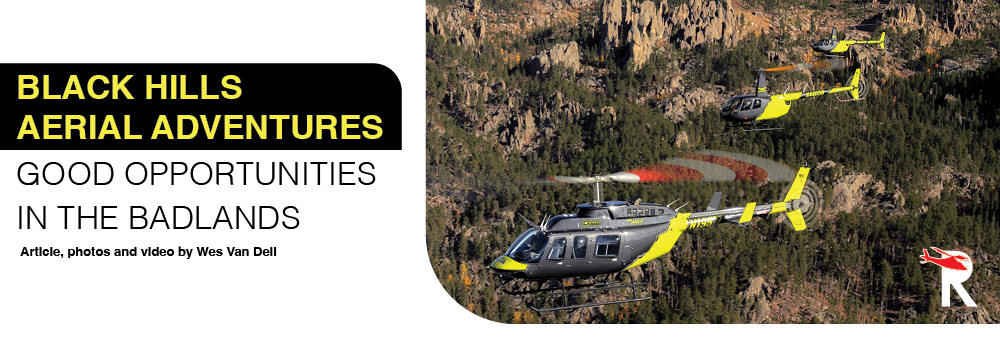
VIEW VIDEO FEATURE
On the side of a busy road on the way to Mount Rushmore in Custer, South Dakota, there’s a sign that reads, “Helicopter Tours, Walk-ins Welcome”. Curiosity and the pull of adventure brings many visitors off the road and into Black Hills Aerial Adventures (BHAA). Outside sits three helicopters with sharp new high contrast paint featuring some of the topography that surrounds the scenic setting. Inside, you’ll be greeted by friendly faces explaining the different tour options that they provide tourists, honeymooners, and families from all over the world. You’d be forgiven for thinking that this is just another tour operator in one of America’s most popular destinations, but behind the scenes there is so much more going on.

For the past 30 years, BHAA has provided tours around Mount Rushmore, Crazy Horse Monument, and to many other scenic destinations in the Black Hills and Badlands of South Dakota. They were quietly going about their business as usual until two years ago, the owners decided to retire and pass their creation on to the next capable owner. Partners Mark Schlaefli and John Wells were very interested, seeing the potential in the operations, location, and a new focus: creating the next generation of helicopter pilots.
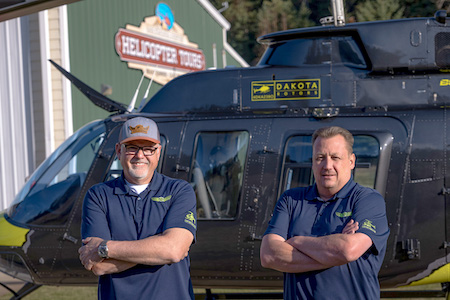
New owners Mark Schlaefli and John Wells
Schlaefli was formerly with Papillon and Sundance Helicopters in Las Vegas and currently serves as the board liaison for the workforce development working group for HAI. Having risen through the ranks as a tour pilot, chief pilot, director of operations and now owner, Mark has firsthand experience of the challenges that the helicopter industry faces. He is driven to solve one of the industry's greatest threats: the shortage of professional, qualified helicopter pilots in all areas of the industry. Pre-COVID, Mark was instrumental in developing one of the first established career pathway programs, SKYPATH, providing a pipeline between flight schools and Sundance Helicopters and further into Air Methods. This is something that the helicopter industry has been lacking that the fixed-wing airline industry excels at, providing the light at the end of the tunnel to new pilots getting into the helicopter industry. Post-COVID, he is taking that same initiative to Black Hills Aerial Adventures, giving young pilots a chance to prove themselves while building meaningful experience towards their next career goals.
What Schlaefli and Wells are really providing is opportunity. “A traditional business would say that we are here to make a profit. We’re here for workforce development,” states Schlaefli. For decades the most traditional path into the helicopter industry outside the military has been to earn your flight instructor certificates and build your hours instructing before moving on into higher tier jobs. That has presented a major obstacle to pilots that have no interest in teaching. With low hours and little opportunity, it has forced a lot of otherwise qualified pilots to give up on their career ambitions. Schlaefli wants to change that. “Not everyone wants to be a flight instructor, nor should they be quite frankly. There needs to be a viable alternative.”
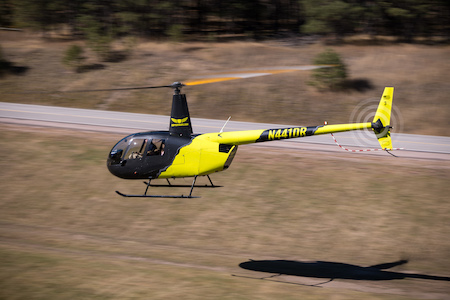
When you start talking with the staff working at Black Hills Aerial Adventures you quickly realize one thing, they’re all pilots. Some of them are fresh out of flight school with 200 hours and excited to be in South Dakota. Here, they have an opportunity to prove themselves both as a professional and as a pilot to continue developing their experience. They work the counter, greeting customers, clean the aircraft in the mornings, provide safety briefings to passengers, and take photos of smiling faces once they’ve completed their tour. In between all that, they fly. During their first season, it may be maintenance flights or relocation flights moving from one base to another as they learn the ropes of the operation. After that, it’s tours in the R44. If they come back for another season they may progress to the R66 or LongRanger to get some turbine experience. Eventually, they will have the opportunity to move into the Part 135 world with Dakota Rotors, BHAA’s Part 135 certificate holder. “In the busy season, we will fly five hours a day typically” reflects Austyn Schlueter who is in his third season at BHAA. Schlueter now lives full time in nearby Rapid City making him one of the few local pilots. The rest are mostly seasonal from all over the U.S. In addition to experience, BHAA also provides housing for them, complete with an outside camping area and a scenic view of the Black Hills. “There’s a great sense of comradery amongst the pilots. We have a lot of fun here,” says Schlueter.
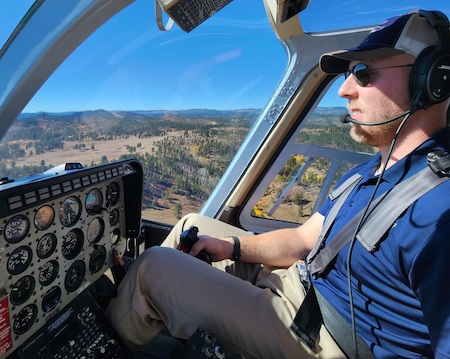
3rd year tour pilot Austyn Schlueter flying the Bell 206L4
Not everyone is cut out for this type of position, especially as a young pilot. What Schlaefli and his team are looking for is the pilot who is willing to get their hands dirty. Willing to do the small things for the betterment of the operation as they continue their development. “A great fit for this team is someone who is not afraid to take on any task. Although we are all pilots, I’m trying to level the playing field as much as possible with ego,” says Schlaefli. Professionalism is a big piece of the puzzle that he is trying to solve. Hours in a logbook are important, but the right attitude is something that employers are seeing less and less of throughout the industry. Quality of hours are also important to the next step in their pilots’ careers. Schlaefli recognizes that for most, BHAA is a transition to other things like helicopter air ambulance (HAA) and aerial firefighting. In order to get there, cross-country and night experience are crucial but generally lacking in tour operations. Schlaefli provides those opportunities as often as he can to help pilots reach those goals, sacrificing profit for workforce development.
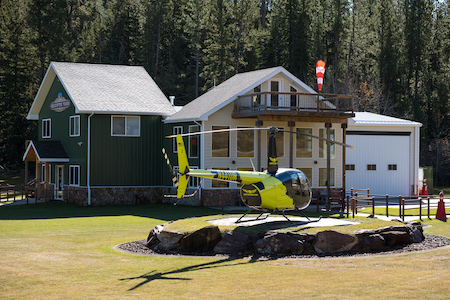
Black Hills Aerial Adventures base in Custer, SD
The next step for Black Hills Aerial Adventures is expansion into some of those areas themselves. Dakota Rotors holds the Part 135 certificate that eventually Schlaefli and Wells would like to encompass all of their operations. In addition to BHAA they own a few other small tour operations like Badlands Helicopters in western South Dakota. They also operate a wide variety of aircraft from leased R44s, to classic Bell 47s. It’s time to put that model behind them and focus on the airframes that are most suitable for their operations as they bring everything under one umbrella. Consolidation of brands and diversification of operations will provide additional opportunity for pilots who are looking to gain Part 135 experience or even limited HAA experience. Retention of pilots will also reduce training expenses every season, a major hurdle for the high-turnover tour industry. That reduction in training cost by providing ongoing opportunity will mean stability for BHAA and, as Wells envisions, increased pay for pilots. The future looks promising for the business as well as for the pilots moving through the ranks at BHAA.
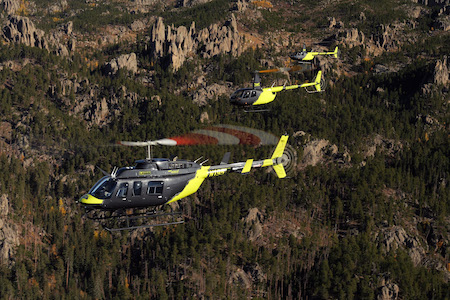
The future BHAA fleet will consist of Robinson R44, R66, and Bell 206 aircraft
No business in our industry operates without challenges, however. One of the threats that BHAA faces comes from the National Parks Service (NPS) Air Traffic Management Plan (ATMP). The National Parks Air Tour Management Act of 2000 established the creation of ATMPs for National Parks across the country. Since then, BHAA and Badlands Helicopters have operated under agreements put in place before the act was placed. Now, the FAA and NPS have faced increasing pressure to further restrict air tours in these parks and enact ATMPs that would severely limit the area that tours have access to. This threat not only affects the way that the public can view these landmarks, but also the safety of the operations themselves, forcing them into smaller and smaller boxes. What’s more is that the FAA and NPS are proceeding without input from the principal operators themselves. “In fact, I am not anti-ATMP. I think they are necessary. What I am against is the way that the NPS is going about it,” states Schlaefli. “There is a process that works for everybody, and the park service has chosen to go down a different road.”
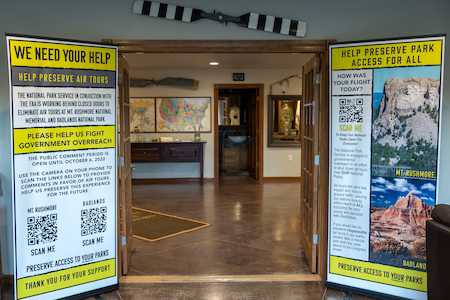
Call to action signs that greet visitors to BHAA
Input from operators and the general public are what can save these types of operations. When you walk in the lobby of BHAA you’re greeted by two large banners imploring visitors to scan a QR code and provide feedback to the FAA and NPS. “We need your help,” they state. HAI has also weighed in, creating a call to action for members to submit comments. What happens in the Black Hills and Badlands of South Dakota could have a far-reaching effect on the rest of the helicopter tour industry. “Who stands to suffer the most are the public and the differently abled, who can’t experience these parks on foot or on ATV etc. You can’t get these views in any other way. These are their lands too.“
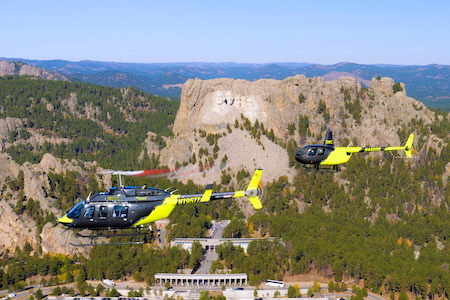
Providing the best views of Mount Rushmore for 30 years and counting
Regardless of the outcome, Black Hills Aerial Adventures will continue to provide the best views of Mount Rushmore and a great opportunity for aspiring pilots everywhere to achieve their dreams in the helicopter industry. Schlaefli says, “It’s the biggest mission we could possibly fulfill.”
VIEW VIDEO
READ MORE ROTOR PRO: https://justhelicopters.com/Magazine
WATCH ROTOR PRO YOUTUBE CHANNEL: https://buff.ly/3Md0T3y
You can also find us on
Instagram - https://www.instagram.com/rotorpro1
Facebook - https://www.facebook.com/rotorpro1
Twitter - https://twitter.com/justhelicopters
LinkedIn - https://www.linkedin.com/company/rotorpro1